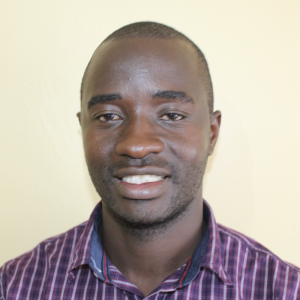The houses in Bumavi are made of mud walls with roofs made of iron sheets. The village is quiet in the morning and afternoon, but gets very noisy in the evening when children return from school. Community members practice agriculture on their small pieces of land. It is a rural village that is home to 210 people, tucked away from the noise of town life.
Many people grow tea and various vegetables. If a family doesn't have their own farm, the adults will often work on another person's farm for a small fee. Others go out to Shamakhokho to work at the schools or market.
Community members are always awake by 5:30 am to take care of livestock and work on the farm before the heat of midday. However, fetching water is a task that interrupts this work. Water is not found at home, but is found at Joseph Njajula Spring.
It is so disturbing to see people drawing their water from Njajula Spring. There is a lot of rubbish both by and in the water. Plastic bags, tree leaves, and even a red sandal were in the water. People step into the water and dunk their container under the surface until full, careful to avoid debris. People don't treat this water even though it is visibly dirty. Community members believe that they have adapted to the dirty water and that they will remain safe.
However, they reported that diarrhea and malaria have cost them a lot of money when they go to the hospital looking for treatment. They agree that they have had a problem in moving forward in various areas of their lives because their time and money is spent in hospitals.
"We have become an object of scorn to people from villages that have protected springs. We have even entered quarrels with those who have insulted us after their springs were protected. Our self esteem has been lowered," said 12-year-old Vivian.
If you want to learn more about the history of Joseph Njajula Spring, scroll down to the last section of this report.
What we can do:
Spring Protection
We will protect the spring to ensure that the water is safe, adequate, and secure. Construction will keep surface runoff and other contaminants out of the water. There will be stairs down to the collection point and a pipe that can easily fill water containers. With the community’s high involvement in the process, there should be a good sense of responsibility and ownership for the new clean water source.
Training
"Sometimes people come and get water from this spring then go to bathe in the nearby bush that is at the upper part of spring. That means dirty water flows back into the spring and it is so absurd to drink dirt from another person's dirty body. Most homes do not have compost pits and this also forces them to throw garbage anyhow, and this can lead to spread of diseases," said Mrs. Agubasu.
Community members will attend hygiene and sanitation training for at least two days. This training will ensure participants have the knowledge they need about healthy practices and their importance. The facilitator plans to use PHAST (Participatory Hygiene and Sanitation Transformation), CLTS (Community-Led Total Sanitation), ABCD (Asset-Based Community Development), group discussions, handouts, and demonstrations at the spring. One of the most important topics we plan to cover is the handling, storage, and treatment of water. Having a clean water source will be extremely helpful, but it is useless if water gets contaminated by the time it’s consumed.
Training will also result in the formation of a committee that will oversee operations and maintenance at the spring. They will enforce proper behavior around the spring and delegate tasks that will help preserve the site, such as building a fence and digging proper drainage. The fence will keep out destructive animals, and the drainage will keep the area’s mosquito population at a minimum.
Sanitation Platforms
On the final day of training, participants will select 5 families that should most benefit from new cement latrine floors.
Training will also inform the community and selected families on what they need to contribute to make this project a success. They must mobilize locally available materials, such as bricks, clean sand, hardcore, and ballast. The five families chosen for sanitation platforms must prepare by sinking a pit for the sanitation platforms to be placed over. All community members must work together to make sure that accommodations and food are always provided for the work teams.
The History of Joseph Njajula Spring
In the year 1964, the late Joseph Njajula went to the back of his property with the idea of digging a fish pond in a swampy area to rear fish; a project he hoped would get him and his family out of poverty. He then discovered a corner that had many spring eyes with a lot of water oozing up from the ground.
His family was currently walking a long time to queue at Esther Spring to get water. His son got a black eye as a result of fighting over water at Esther Spring, an event that led Mr. Njajula to engage in a painful exchange of words as each man defended their own son. Discovering the spring on his land was indeed a miracle, and a good way to stay away from the trouble of having to get water from Esther Spring.
He put the idea of digging a fish pond off, as the idea of having their own water spring became a priority. He then shared the good news with his wife, Serifa Agubasu, and the rest of his neighbors. They joined hands and began to protect it using local materials, then directed its overflow to a fish pond that was later constructed down the way.
However, the pressure of the spring water was too much, and one morning community members were taken aback to find the headwall broken and swept away. The fish pond had overflowed and most of the fish had been swept away. Mr. Njajula removed the little fish that remained and sold them. His wife says they really took a big loss since they had invested much in buying fingerlings. The area was excavated anew and it was left as is, as the landowner said he would never engage in fish farming again. After their protected spring was broken and destroyed beyond repair, they just decided to use the spring water as is without protecting it as they believe that they did not have the financial ability to buy the hardware materials to construct a durable, good protected spring like the ones we do, nor did they have money to pay good artisans. Doing it by themselves was not an option since they had already tried and failed terribly.
It has been a burden on their hearts to have the spring protected since the landowner's last words before he died in 2009 were, "struggle as much as you can to ensure that that spring is protected in a modern way, and make sure my name is written on it since I am the one that discovered this spring and because it is also on my land. That way, my grandchildren and great-grandchildren will remember me and speak well of me even in my absence. It is a legacy I have left."
Being a village where people believe in honoring the wishes of the dead, the sons of this man embarked on a mission to find artisans to protect their spring, but the cost was too high and they gave up. They have since believed that their father's soul is not at peace with them. Even the wife to the late Njajula was so stressed that her husband's wish would not be fulfilled. But the recent protection of Esther Spring attracted their attention. They learned that an organization from the USA was funding projects by providing hardware materials and paying the skilled artisans. This brought them a huge ray of hope, and that's how this process began.

 Protected Spring
Protected Spring
 Rehabilitation Project
Rehabilitation Project








































